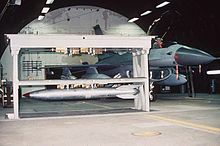Weapons Storage and Security System
The standard system had functioned since the late 1940s, but was unsatisfactory for overseas duty in multiple regards: primarily, it required the weapons be kept mounted on the body of the alert aircraft to ensure they could take off quickly enough when called (despite aircraft not being designed to safely or securely store nuclear weapons).
Secondarily, it also posed an OPSEC risk, as any large amount of activity around the weapons bunkers during a time of crisis would be quickly spotted by the Soviets and interpreted as a prelude to nuclear attack.
Lastly, there was a serious risk that wartime damage to airbases from a first strike using nuclear airburst or persistent chemical weapons attack would deny access to the bunkers for many weeks without actually destroying them, thus creating a much-feared "soft kill" scenario in which most of NATO's theater-based nuclear assets could be rapidly neutralized by a much smaller number of Soviet "soft" area denial strikes.
One vault can hold up to four nuclear weapons and in the lowered position provides ballistic protection through its hardened lid and reinforced sidewalls.
The electronic systems include various classified sensors, along with electronic data-transmission and security equipment such as video, motion detectors, closed circuit TV and thermal imaging devices, thus making the WS3 shelters more secure against sabotage and infiltration compared to existing igloo-style bunkers.


